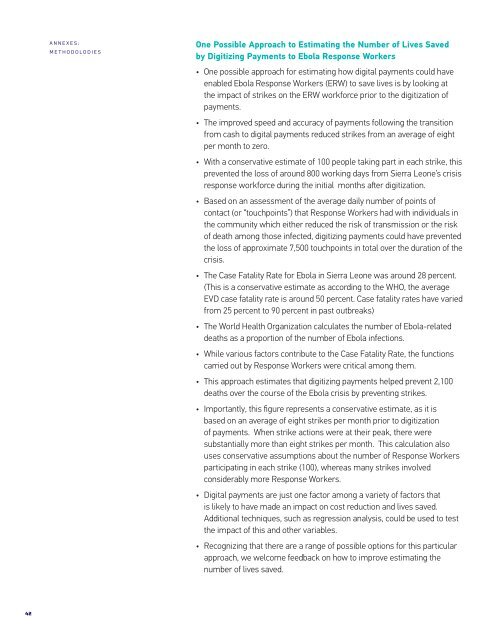LEONE
1U6Dtu2
1U6Dtu2
Create successful ePaper yourself
Turn your PDF publications into a flip-book with our unique Google optimized e-Paper software.
ANNEXES:<br />
METHODOLODIES<br />
One Possible Approach to Estimating the Number of Lives Saved<br />
by Digitizing Payments to Ebola Response Workers<br />
• One possible approach for estimating how digital payments could have<br />
enabled Ebola Response Workers (ERW) to save lives is by looking at<br />
the impact of strikes on the ERW workforce prior to the digitization of<br />
payments.<br />
• The improved speed and accuracy of payments following the transition<br />
from cash to digital payments reduced strikes from an average of eight<br />
per month to zero.<br />
• With a conservative estimate of 100 people taking part in each strike, this<br />
prevented the loss of around 800 working days from Sierra Leone’s crisis<br />
response workforce during the initial months after digitization.<br />
• Based on an assessment of the average daily number of points of<br />
contact (or “touchpoints”) that Response Workers had with individuals in<br />
the community which either reduced the risk of transmission or the risk<br />
of death among those infected, digitizing payments could have prevented<br />
the loss of approximate 7,500 touchpoints in total over the duration of the<br />
crisis.<br />
• The Case Fatality Rate for Ebola in Sierra Leone was around 28 percent.<br />
(This is a conservative estimate as according to the WHO, the average<br />
EVD case fatality rate is around 50 percent. Case fatality rates have varied<br />
from 25 percent to 90 percent in past outbreaks)<br />
• The World Health Organization calculates the number of Ebola-related<br />
deaths as a proportion of the number of Ebola infections.<br />
• While various factors contribute to the Case Fatality Rate, the functions<br />
carried out by Response Workers were critical among them.<br />
• This approach estimates that digitizing payments helped prevent 2,100<br />
deaths over the course of the Ebola crisis by preventing strikes.<br />
• Importantly, this figure represents a conservative estimate, as it is<br />
based on an average of eight strikes per month prior to digitization<br />
of payments. When strike actions were at their peak, there were<br />
substantially more than eight strikes per month. This calculation also<br />
uses conservative assumptions about the number of Response Workers<br />
participating in each strike (100), whereas many strikes involved<br />
considerably more Response Workers.<br />
• Digital payments are just one factor among a variety of factors that<br />
is likely to have made an impact on cost reduction and lives saved.<br />
Additional techniques, such as regression analysis, could be used to test<br />
the impact of this and other variables.<br />
• Recognizing that there are a range of possible options for this particular<br />
approach, we welcome feedback on how to improve estimating the<br />
number of lives saved.<br />
42



